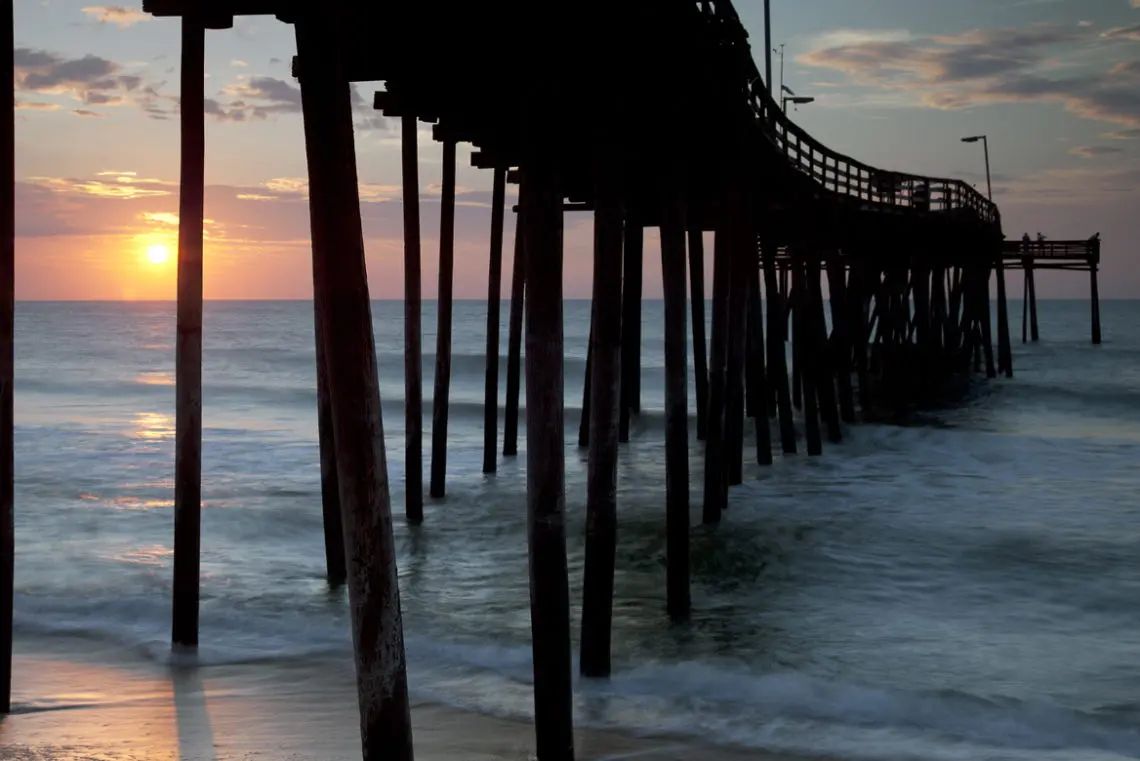First publicly conceived in 1808 by the U.S. Secretary of the Treasury, Albert Gallatin, the concept of a national, protected, north-south waterway was introduced in his report to President Thomas Jefferson that year. Gallatin noted that the United States possessed an inland navigation solution from Massachusetts to Georgia (then the southernmost Atlantic state) that was "principally, if not solely" interrupted by a mere four stretches of land - Cape Cod, a section of New Jersey between the Raritan and Delaware rivers, the peninsula between the Delaware River and the Chesapeake Bay, and the marshy tract between the Chesapeake Bay and the Albemarle Sound.
By 1808, there were but a handful of fairly successful manmade canals in the country, and many more were either already under construction or soon would be. Gallatin explained in his report that if the federal government would appropriate the necessary funds then these mere four stretches of land could be dredged with new canals, therefore a sea vessel could travel by rivers, bays, sounds, and a handful of canals from Boston to Beaufort, North Carolina
, on down to the Cape Fear River, then broken by a short ocean run the inland navigation could continue again inside the chain of barrier islands skirting the coasts of South Carolina and Georgia.
Secretary Gallatin estimated that the cost of the four canals would be $3 million. His entire scheme for roads and canals would cost an expected $20 million. By setting aside $2 million per year from the annual Treasury surplus (then in excess of $5 million), the whole project envisioned could be accomplished within ten (10) years.
Delayed by foreign problems (the War of 1812 comes to mind) and further frustrated by domestic obstructions (President Jefferson was not entirely sold on the idea), Gallatin's plan was never fully implemented. His concept of an Intracoastal Waterway never died, but the waterway ultimately came into being mostly due to local projects rather than centralized planning during the nineteenth century. And instead of taking ten years, its construction spanned more than a century.
The Atlantic Intracoastal Waterway, conceived by Secretary Albert Gallatin in 1808, was not essentially completed until the 1930s - in the midst of the Great Depression. It is a hybrid creation of man comprised of many existing (although upgraded) riverways, man-made canals, and existing sounds and bays. The waterway came into being through a series of local projects developed in expectation of local benefits. Today, commerce south of Norfolk is almost entirely domestic and mostly short haul. It is now used more for recreation than for commerce. And, it is no longer maintained to the width and depth as it was during the peak of its usage.
In the state of North Carolina, canal building started soon after the U.S. Revolution. The Dismal Swamp Canal first connected the Chesapeake Bay of Virginia with the Albemarle Sound in North Carolina in 1805, but it was not fully useful until 1829. By 1859, a second major canal - the Albemarle & Chesapeake Canal - was completed to connect Virginia and North Carolina more effectively, almost putting the Dismal Canal out of business. After the U.S. Civil War and most of Reconstruction was behind them, North Carolinians launched several new canal projects, including the rework of some existing canals plus the dredging of several new ones.
In 1912, the U.S. Army Corps of Engineers submitted a report to Congress on their survey of the long-considered Intracoastal Waterway from Boston, MA to Beaufort, NC
. They recommended that the existing Albemarle & Chesapeake Canal be redredged to a depth of twelve (12) feet and that it be considered as the primary route for the waterway. Congress approved, and on April 30, 1913 the U.S. government purchased the Albemarle & Chesapeake Canal for $500,000 and construction began soon thereafter.
Known officially as the "Inland Waterway from Norfolk, VA to Beaufort Inlet, NC" this segment of the overall project was completed in 1932. Congress modified the project in 1917 and 1918 to permit changes to the route, and in 1930 to provide for the construction of a new tidal guard lock (600' x 75') at the Elizabeth River entrance to the Albemarle & Chesapeake Canal.
Covering roughly 120 miles from Norfolk to Beaufort
, the waterway varied in bottom width from ninety (90) feet in land cuts to one hundred (100) feet in open waters. Upon leaving the Albemarle Sound, it avoided the broad Pamlico Sound and followed a succession of rivers, creeks, bays, and land cuts from the Alligator River to the Newport River, which leads to the Beaufort Inlet. Prior to the adoption of the project by Congress, the Corps had already improved some of these watercourses, and beginning in 1837, had made seven (7) previous surveys for the total route.
With traffic again falling, the Dismal Canal Company finally convinced the U.S. government to take over the canal. In 1925, Congress finally agreed to purchase it as an "adjunct" (alternate) to the currently-proposed Albemarle & Chesapeake route. Tranfer of title happened in 1929. The Corps then set about to upgrading the Dismal Swamp Canal, including replacing the old timber locks with steel and concrete chambers (300' x 50').
In 1913, the U.S. Army Corps of Engineers submitted its next report to Congress on the next phase of the Intracoastal Waterway - from Beaufort, North Carolina
to Key West, Florida. Those making and presenting the survey recommended a ten-foot deep waterway for the entire distance of 925 miles, to be completed in six (6) years at an estimated cost of $31 million. Brigadier General William H. Bixby, the Chief of Engineers, concurred with the need, but saw no urgency for one ten feet deep or, in view of the sparse population of Florida at that time, for construction as far south as Key West.
He recommended a seven-foot canal as far south as the St. John's River, which was estimated to cost about $14.4 million. The Board of Engineers for Rivers and Harbors declined to endorse either recommendation. Congress took no action either. Ultimately, this "phase" was developed, not as a single project, but in several sections improved by stages in response to expectations of commercial benefit. The entire Intracoastal Waterway remained a string of variously-named projects until 1947, when all but the last two of the southern reaches were collectively designated the "Atlantic Intracoastal Waterway between Norfolk, VA and St. John's River, FL."
From Beaufort
to Cape Fear the waterway included the rebuilt Harlowe Canal (replacing the old Clubfoot Creek to Harlow Creek Canal) to connect the Pamlico Sound with the Bogue Sound, then followed barrier islands to Swansboro. Navigation improvements between Beaufort
and Swansboro begain in 1886 and between Swansboro and the New River in 1890. In 1917, Congress consolidated the three works under the designation "Inland Waterway, Beaufort
to Jacksonville, NC, which provided for a channel 100 feet wide and three (3) feet deep at mean low water between Beaufort
and Swansboro, thence forty (40) feet wide and three (3) to four (4) feet deep at mean high water to New River, thence forty (40 feet wid and three (3) feet deep at mean low water to Jacksonville.
In 1927, Congress authorized a twelve (12) foot channel through Federal Point peninsula to the Cape Fear River, and the Corps completed this segment in five (5) years.
Begun in 1930, the project then passed down the Cape Fear River to Southport, near the river's mouth, the Intracoastal Waterway then followed the Elizabeth River (Brunswick County) to its headwaters, cut 2.6 miles through high ground to the head of Davis Creek, descended this creek, and continued through coastal sounds and marshes to the Little River in South Carolina. The waterway ascended the Little River to its headwaters, cut nearly twenty-two (22) miles through land to the head of Socastee Creek, thence followed the creek and the Waccamaw River to Winyah Bay - a complete distance of 94.5 miles, ending at Georgetown, South Carolina.
This last segment in North Carolina (which extended well into South Carolina) provided for a waterway eight (8) feet deep and seventy-five (75) feet wide, and was completed in 1936. The next year, Congress approved a channel twelve (12) feet deep with a bottom width of not less than ninety (90) feet. In 1938, provision was made for the construction of a yacht basin in Southport, North Carolina - completed in 1940.
If you're searching for great pizza on the Outer Banks, look no further than Cosmo's Pizzeria at The Marketplace in Southern Shores! We offer authentic New York-style pizza made fresh and just the way you like, using only the highest quality...
Check out Corolla's newest 5-star attraction! Pirate-Themed 18-Hole Minature Golf Course and Arcade with waterfalls, a pirate ship, caves, skulls, and more! So much fun for the whole family! Come...
Join Captain Stuart Wescott aboard The Captain Johnny boat for a Guaranteed Dolphin Watch cruise in protected waters off the Outer Banks, NC. This two hour cruise is ideal for all ages. Enjoy breathtaking views as you listen to a...




